Year 12 Maths Project: Critical Path Analysis and Modeling
VerifiedAdded on 2023/01/20
|7
|1165
|22
Project
AI Summary
This project presents a comprehensive analysis of a real-life scenario using critical path analysis and simulation techniques. The assignment addresses various aspects of project management, including identifying critical paths, calculating waiting times in a queuing system, and modeling patient flow in a clinic setting. The student analyzes patient arrival times, consultation lengths, and service times to determine average waiting times and identify potential bottlenecks. The project involves constructing tables and charts to visualize data and applying mathematical concepts to model the system. The student also considers practical issues such as equipment failures and resource allocation. Furthermore, the project explores the use of simulation modeling to represent queuing systems and determine the most appropriate method for displaying trends and averages over a given period. The assignment concludes with an analysis of the doctor's free time and a discussion of how the information can be used to improve efficiency.

Running head: PERFORMING CRITICAL PATH ANALYSIS
Performing Critical Path Analysis
Name of the Student
Name of the University
Author note
Performing Critical Path Analysis
Name of the Student
Name of the University
Author note
Paraphrase This Document
Need a fresh take? Get an instant paraphrase of this document with our AI Paraphraser
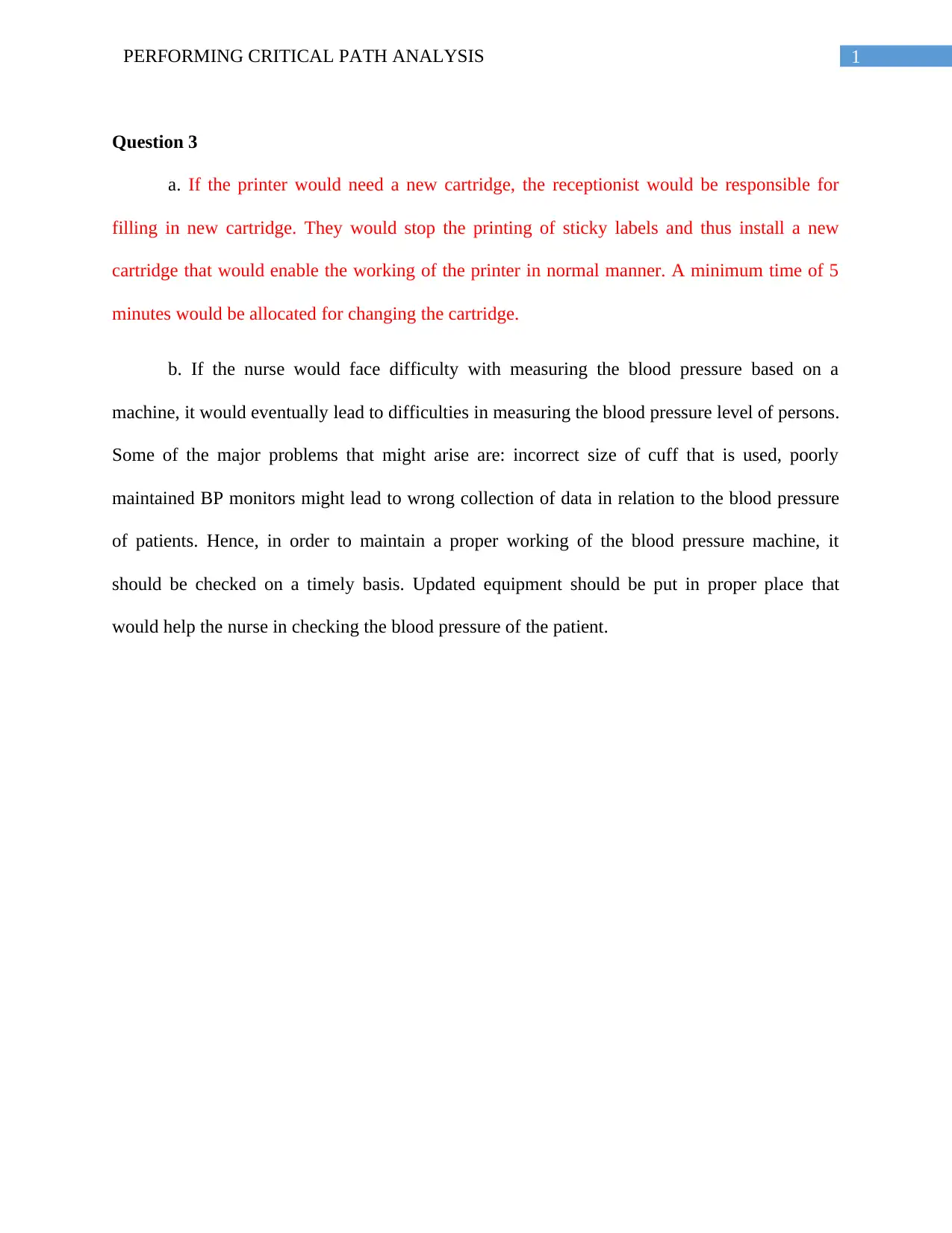
1PERFORMING CRITICAL PATH ANALYSIS
Question 3
a. If the printer would need a new cartridge, the receptionist would be responsible for
filling in new cartridge. They would stop the printing of sticky labels and thus install a new
cartridge that would enable the working of the printer in normal manner. A minimum time of 5
minutes would be allocated for changing the cartridge.
b. If the nurse would face difficulty with measuring the blood pressure based on a
machine, it would eventually lead to difficulties in measuring the blood pressure level of persons.
Some of the major problems that might arise are: incorrect size of cuff that is used, poorly
maintained BP monitors might lead to wrong collection of data in relation to the blood pressure
of patients. Hence, in order to maintain a proper working of the blood pressure machine, it
should be checked on a timely basis. Updated equipment should be put in proper place that
would help the nurse in checking the blood pressure of the patient.
Question 3
a. If the printer would need a new cartridge, the receptionist would be responsible for
filling in new cartridge. They would stop the printing of sticky labels and thus install a new
cartridge that would enable the working of the printer in normal manner. A minimum time of 5
minutes would be allocated for changing the cartridge.
b. If the nurse would face difficulty with measuring the blood pressure based on a
machine, it would eventually lead to difficulties in measuring the blood pressure level of persons.
Some of the major problems that might arise are: incorrect size of cuff that is used, poorly
maintained BP monitors might lead to wrong collection of data in relation to the blood pressure
of patients. Hence, in order to maintain a proper working of the blood pressure machine, it
should be checked on a timely basis. Updated equipment should be put in proper place that
would help the nurse in checking the blood pressure of the patient.
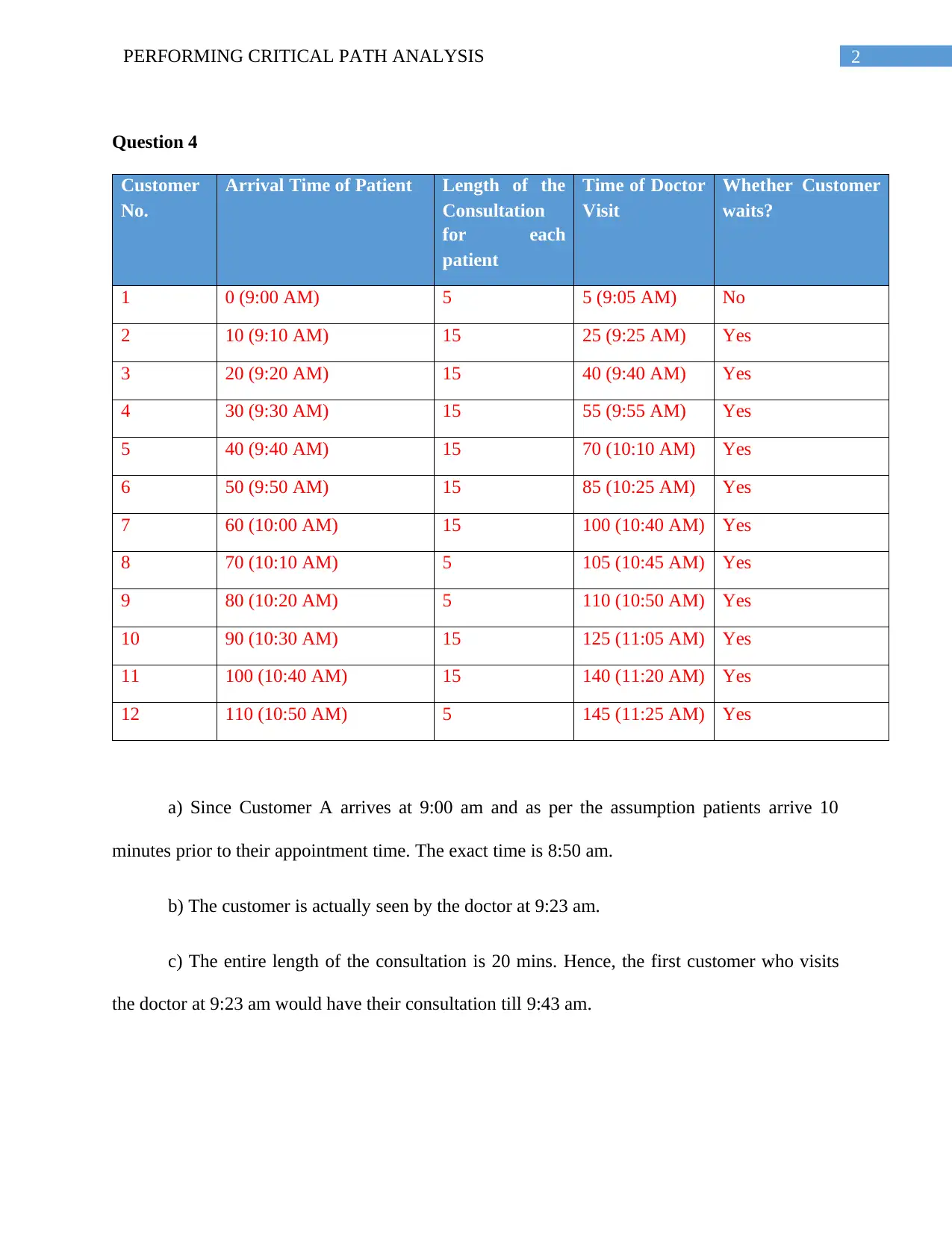
2PERFORMING CRITICAL PATH ANALYSIS
Question 4
Customer
No.
Arrival Time of Patient Length of the
Consultation
for each
patient
Time of Doctor
Visit
Whether Customer
waits?
1 0 (9:00 AM) 5 5 (9:05 AM) No
2 10 (9:10 AM) 15 25 (9:25 AM) Yes
3 20 (9:20 AM) 15 40 (9:40 AM) Yes
4 30 (9:30 AM) 15 55 (9:55 AM) Yes
5 40 (9:40 AM) 15 70 (10:10 AM) Yes
6 50 (9:50 AM) 15 85 (10:25 AM) Yes
7 60 (10:00 AM) 15 100 (10:40 AM) Yes
8 70 (10:10 AM) 5 105 (10:45 AM) Yes
9 80 (10:20 AM) 5 110 (10:50 AM) Yes
10 90 (10:30 AM) 15 125 (11:05 AM) Yes
11 100 (10:40 AM) 15 140 (11:20 AM) Yes
12 110 (10:50 AM) 5 145 (11:25 AM) Yes
a) Since Customer A arrives at 9:00 am and as per the assumption patients arrive 10
minutes prior to their appointment time. The exact time is 8:50 am.
b) The customer is actually seen by the doctor at 9:23 am.
c) The entire length of the consultation is 20 mins. Hence, the first customer who visits
the doctor at 9:23 am would have their consultation till 9:43 am.
Question 4
Customer
No.
Arrival Time of Patient Length of the
Consultation
for each
patient
Time of Doctor
Visit
Whether Customer
waits?
1 0 (9:00 AM) 5 5 (9:05 AM) No
2 10 (9:10 AM) 15 25 (9:25 AM) Yes
3 20 (9:20 AM) 15 40 (9:40 AM) Yes
4 30 (9:30 AM) 15 55 (9:55 AM) Yes
5 40 (9:40 AM) 15 70 (10:10 AM) Yes
6 50 (9:50 AM) 15 85 (10:25 AM) Yes
7 60 (10:00 AM) 15 100 (10:40 AM) Yes
8 70 (10:10 AM) 5 105 (10:45 AM) Yes
9 80 (10:20 AM) 5 110 (10:50 AM) Yes
10 90 (10:30 AM) 15 125 (11:05 AM) Yes
11 100 (10:40 AM) 15 140 (11:20 AM) Yes
12 110 (10:50 AM) 5 145 (11:25 AM) Yes
a) Since Customer A arrives at 9:00 am and as per the assumption patients arrive 10
minutes prior to their appointment time. The exact time is 8:50 am.
b) The customer is actually seen by the doctor at 9:23 am.
c) The entire length of the consultation is 20 mins. Hence, the first customer who visits
the doctor at 9:23 am would have their consultation till 9:43 am.
⊘ This is a preview!⊘
Do you want full access?
Subscribe today to unlock all pages.

Trusted by 1+ million students worldwide
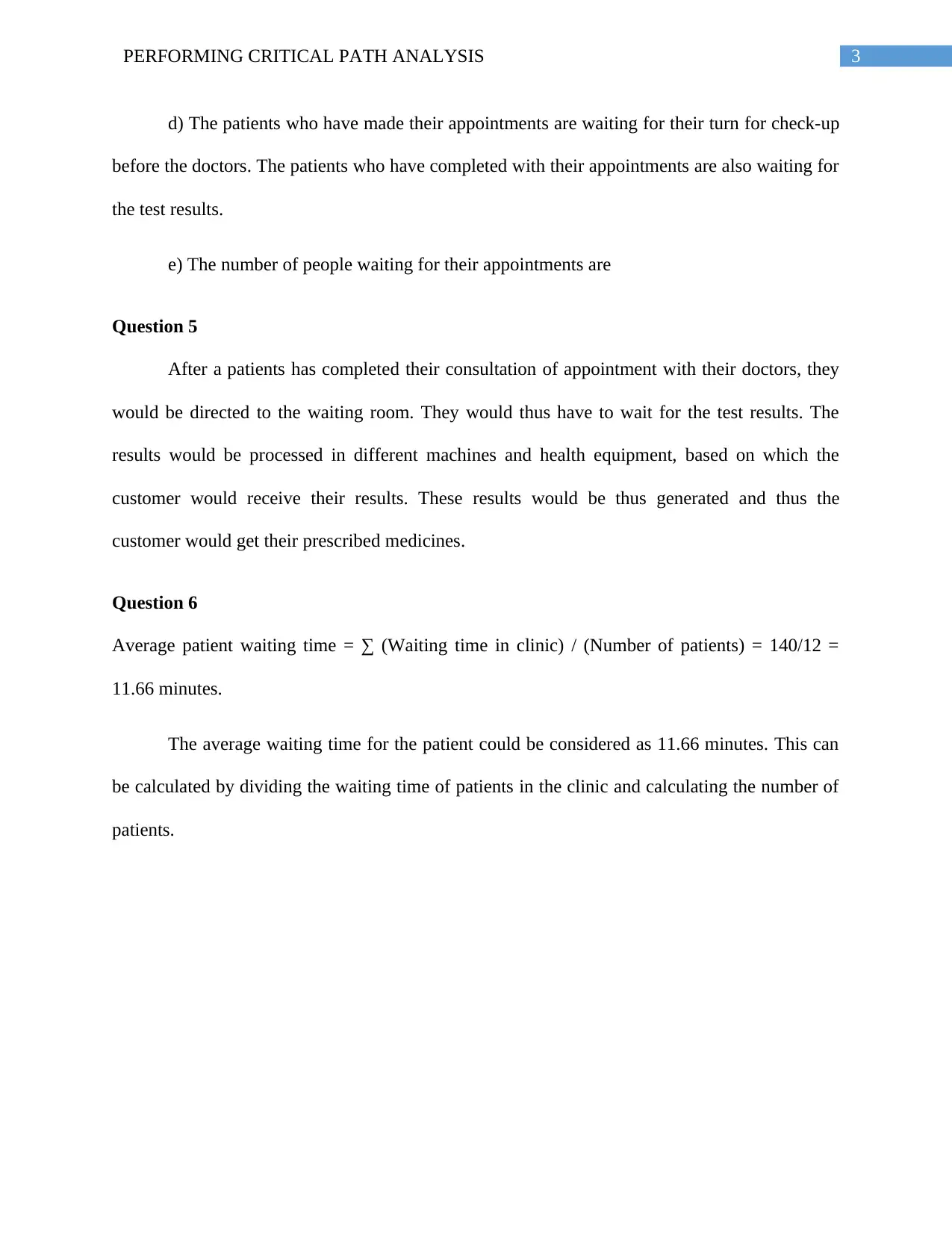
3PERFORMING CRITICAL PATH ANALYSIS
d) The patients who have made their appointments are waiting for their turn for check-up
before the doctors. The patients who have completed with their appointments are also waiting for
the test results.
e) The number of people waiting for their appointments are
Question 5
After a patients has completed their consultation of appointment with their doctors, they
would be directed to the waiting room. They would thus have to wait for the test results. The
results would be processed in different machines and health equipment, based on which the
customer would receive their results. These results would be thus generated and thus the
customer would get their prescribed medicines.
Question 6
Average patient waiting time = ∑ (Waiting time in clinic) / (Number of patients) = 140/12 =
11.66 minutes.
The average waiting time for the patient could be considered as 11.66 minutes. This can
be calculated by dividing the waiting time of patients in the clinic and calculating the number of
patients.
d) The patients who have made their appointments are waiting for their turn for check-up
before the doctors. The patients who have completed with their appointments are also waiting for
the test results.
e) The number of people waiting for their appointments are
Question 5
After a patients has completed their consultation of appointment with their doctors, they
would be directed to the waiting room. They would thus have to wait for the test results. The
results would be processed in different machines and health equipment, based on which the
customer would receive their results. These results would be thus generated and thus the
customer would get their prescribed medicines.
Question 6
Average patient waiting time = ∑ (Waiting time in clinic) / (Number of patients) = 140/12 =
11.66 minutes.
The average waiting time for the patient could be considered as 11.66 minutes. This can
be calculated by dividing the waiting time of patients in the clinic and calculating the number of
patients.
Paraphrase This Document
Need a fresh take? Get an instant paraphrase of this document with our AI Paraphraser
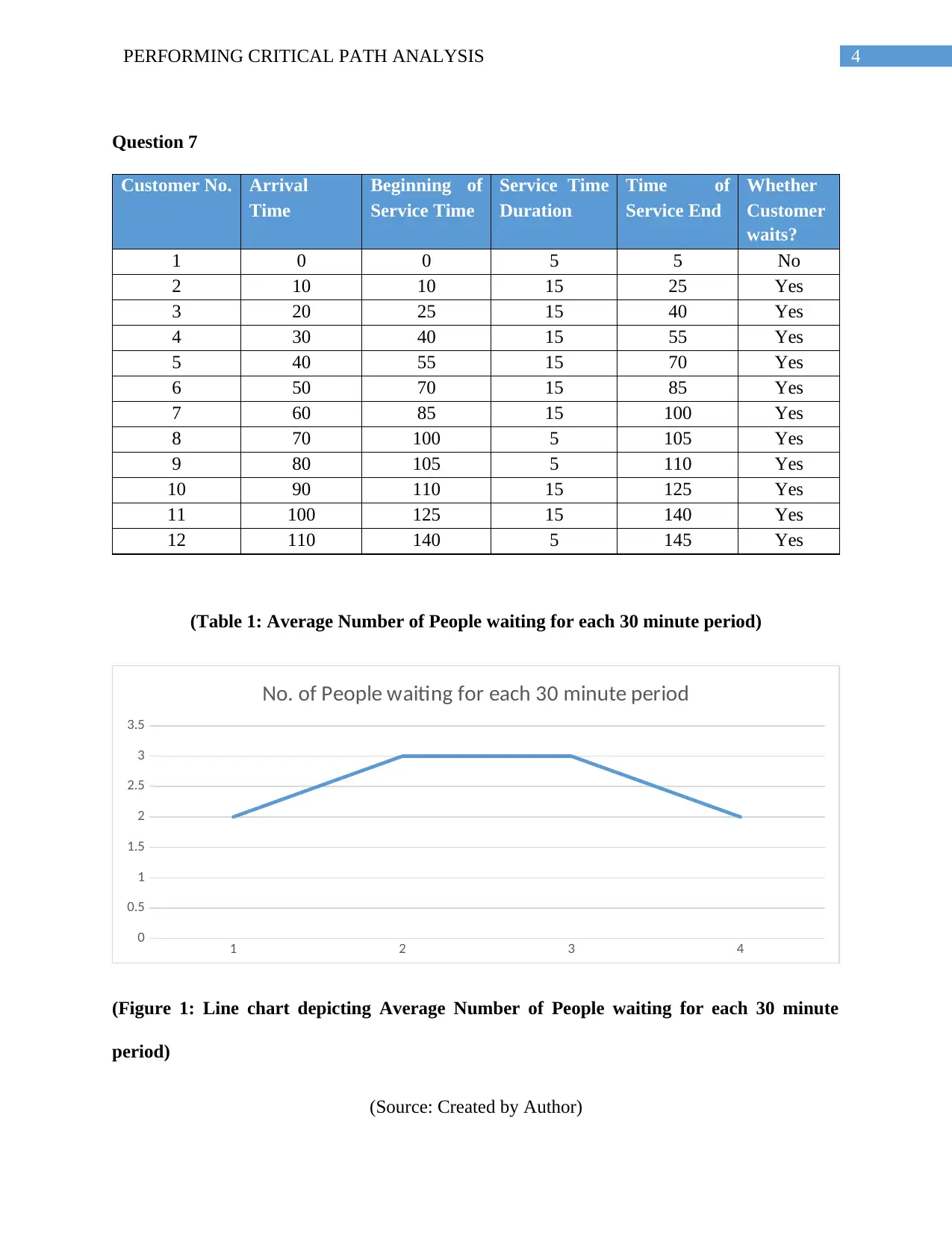
4PERFORMING CRITICAL PATH ANALYSIS
Question 7
Customer No. Arrival
Time
Beginning of
Service Time
Service Time
Duration
Time of
Service End
Whether
Customer
waits?
1 0 0 5 5 No
2 10 10 15 25 Yes
3 20 25 15 40 Yes
4 30 40 15 55 Yes
5 40 55 15 70 Yes
6 50 70 15 85 Yes
7 60 85 15 100 Yes
8 70 100 5 105 Yes
9 80 105 5 110 Yes
10 90 110 15 125 Yes
11 100 125 15 140 Yes
12 110 140 5 145 Yes
(Table 1: Average Number of People waiting for each 30 minute period)
1 2 3 4
0
0.5
1
1.5
2
2.5
3
3.5
No. of People waiting for each 30 minute period
(Figure 1: Line chart depicting Average Number of People waiting for each 30 minute
period)
(Source: Created by Author)
Question 7
Customer No. Arrival
Time
Beginning of
Service Time
Service Time
Duration
Time of
Service End
Whether
Customer
waits?
1 0 0 5 5 No
2 10 10 15 25 Yes
3 20 25 15 40 Yes
4 30 40 15 55 Yes
5 40 55 15 70 Yes
6 50 70 15 85 Yes
7 60 85 15 100 Yes
8 70 100 5 105 Yes
9 80 105 5 110 Yes
10 90 110 15 125 Yes
11 100 125 15 140 Yes
12 110 140 5 145 Yes
(Table 1: Average Number of People waiting for each 30 minute period)
1 2 3 4
0
0.5
1
1.5
2
2.5
3
3.5
No. of People waiting for each 30 minute period
(Figure 1: Line chart depicting Average Number of People waiting for each 30 minute
period)
(Source: Created by Author)
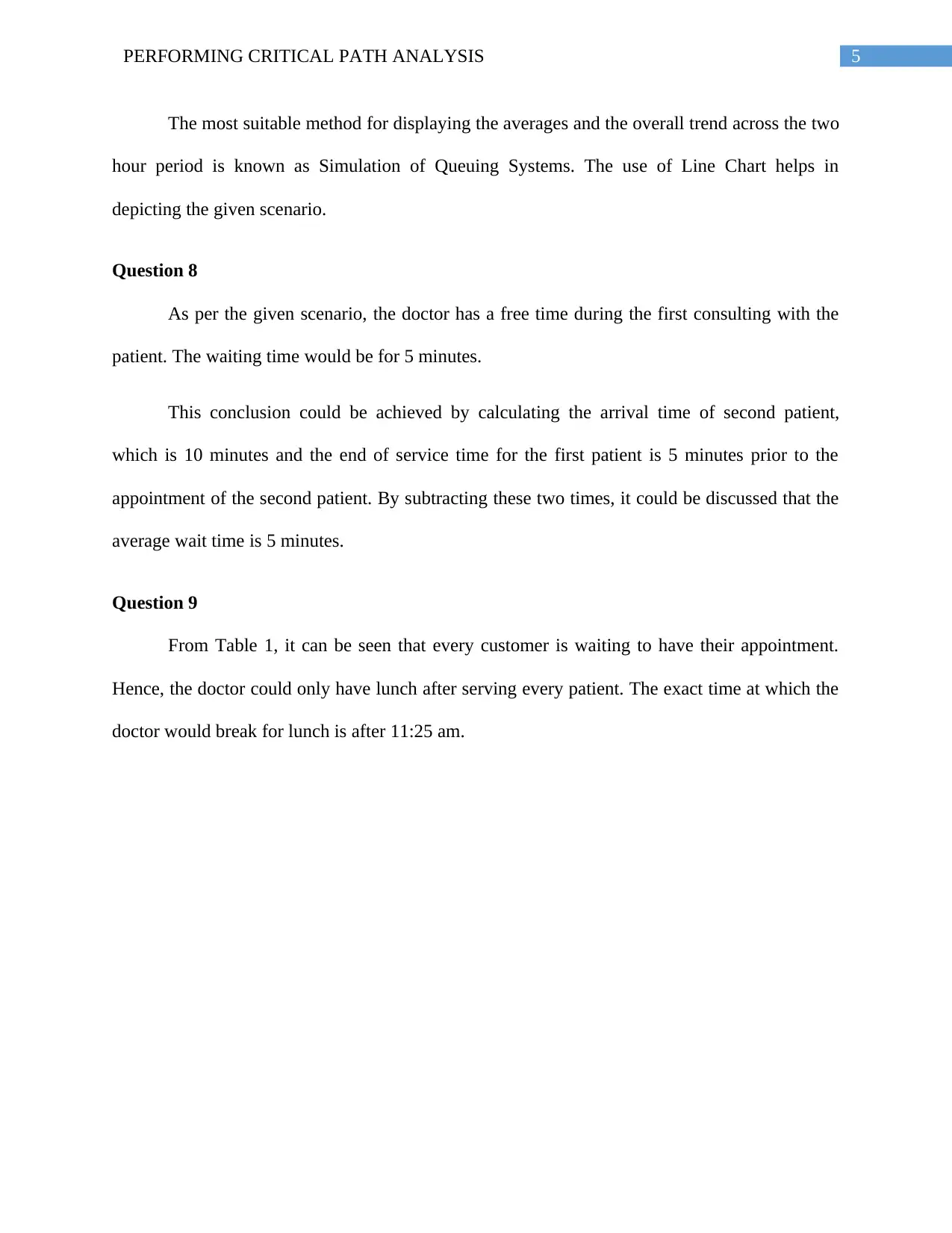
5PERFORMING CRITICAL PATH ANALYSIS
The most suitable method for displaying the averages and the overall trend across the two
hour period is known as Simulation of Queuing Systems. The use of Line Chart helps in
depicting the given scenario.
Question 8
As per the given scenario, the doctor has a free time during the first consulting with the
patient. The waiting time would be for 5 minutes.
This conclusion could be achieved by calculating the arrival time of second patient,
which is 10 minutes and the end of service time for the first patient is 5 minutes prior to the
appointment of the second patient. By subtracting these two times, it could be discussed that the
average wait time is 5 minutes.
Question 9
From Table 1, it can be seen that every customer is waiting to have their appointment.
Hence, the doctor could only have lunch after serving every patient. The exact time at which the
doctor would break for lunch is after 11:25 am.
The most suitable method for displaying the averages and the overall trend across the two
hour period is known as Simulation of Queuing Systems. The use of Line Chart helps in
depicting the given scenario.
Question 8
As per the given scenario, the doctor has a free time during the first consulting with the
patient. The waiting time would be for 5 minutes.
This conclusion could be achieved by calculating the arrival time of second patient,
which is 10 minutes and the end of service time for the first patient is 5 minutes prior to the
appointment of the second patient. By subtracting these two times, it could be discussed that the
average wait time is 5 minutes.
Question 9
From Table 1, it can be seen that every customer is waiting to have their appointment.
Hence, the doctor could only have lunch after serving every patient. The exact time at which the
doctor would break for lunch is after 11:25 am.
⊘ This is a preview!⊘
Do you want full access?
Subscribe today to unlock all pages.

Trusted by 1+ million students worldwide
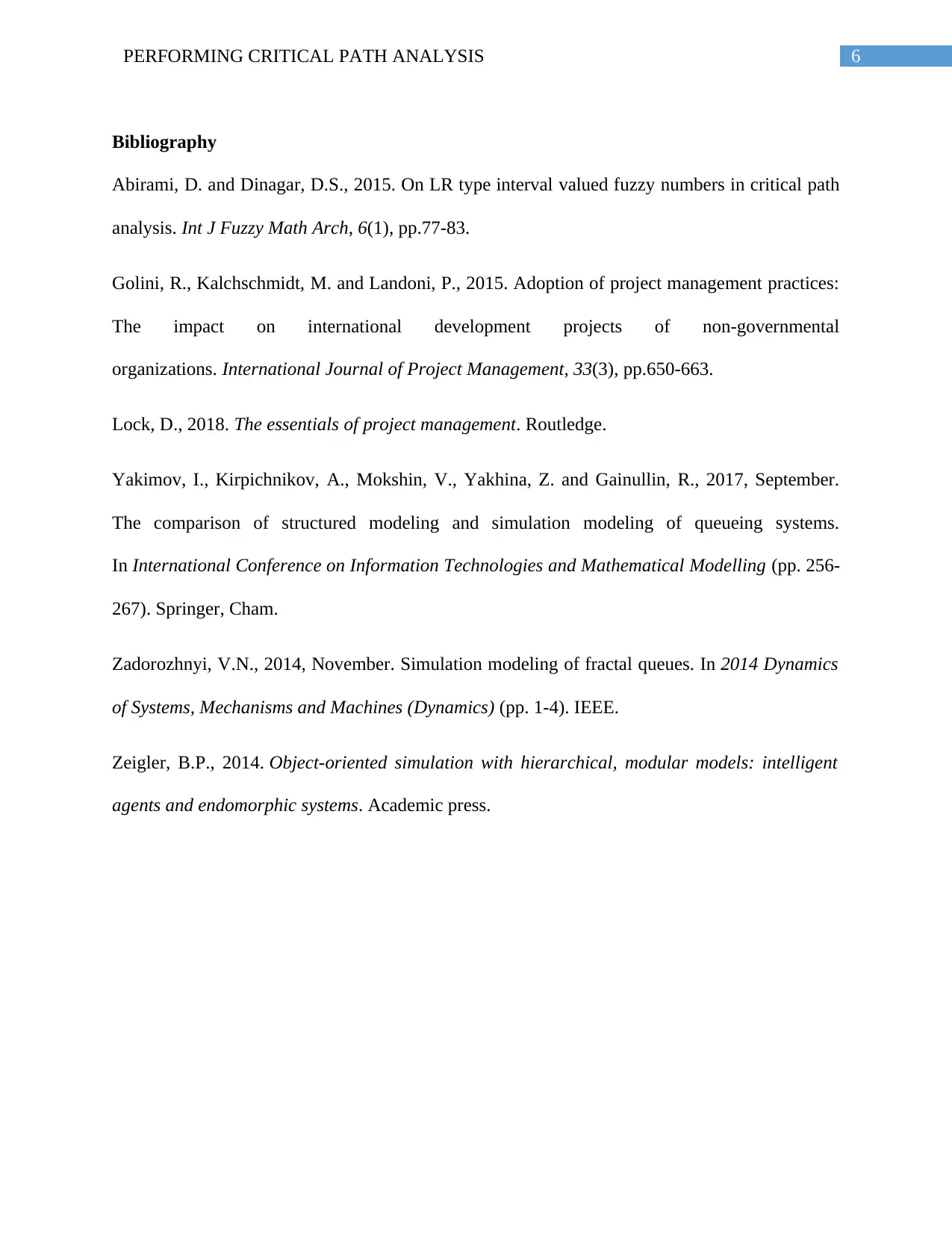
6PERFORMING CRITICAL PATH ANALYSIS
Bibliography
Abirami, D. and Dinagar, D.S., 2015. On LR type interval valued fuzzy numbers in critical path
analysis. Int J Fuzzy Math Arch, 6(1), pp.77-83.
Golini, R., Kalchschmidt, M. and Landoni, P., 2015. Adoption of project management practices:
The impact on international development projects of non-governmental
organizations. International Journal of Project Management, 33(3), pp.650-663.
Lock, D., 2018. The essentials of project management. Routledge.
Yakimov, I., Kirpichnikov, A., Mokshin, V., Yakhina, Z. and Gainullin, R., 2017, September.
The comparison of structured modeling and simulation modeling of queueing systems.
In International Conference on Information Technologies and Mathematical Modelling (pp. 256-
267). Springer, Cham.
Zadorozhnyi, V.N., 2014, November. Simulation modeling of fractal queues. In 2014 Dynamics
of Systems, Mechanisms and Machines (Dynamics) (pp. 1-4). IEEE.
Zeigler, B.P., 2014. Object-oriented simulation with hierarchical, modular models: intelligent
agents and endomorphic systems. Academic press.
Bibliography
Abirami, D. and Dinagar, D.S., 2015. On LR type interval valued fuzzy numbers in critical path
analysis. Int J Fuzzy Math Arch, 6(1), pp.77-83.
Golini, R., Kalchschmidt, M. and Landoni, P., 2015. Adoption of project management practices:
The impact on international development projects of non-governmental
organizations. International Journal of Project Management, 33(3), pp.650-663.
Lock, D., 2018. The essentials of project management. Routledge.
Yakimov, I., Kirpichnikov, A., Mokshin, V., Yakhina, Z. and Gainullin, R., 2017, September.
The comparison of structured modeling and simulation modeling of queueing systems.
In International Conference on Information Technologies and Mathematical Modelling (pp. 256-
267). Springer, Cham.
Zadorozhnyi, V.N., 2014, November. Simulation modeling of fractal queues. In 2014 Dynamics
of Systems, Mechanisms and Machines (Dynamics) (pp. 1-4). IEEE.
Zeigler, B.P., 2014. Object-oriented simulation with hierarchical, modular models: intelligent
agents and endomorphic systems. Academic press.
1 out of 7
Related Documents
Your All-in-One AI-Powered Toolkit for Academic Success.
+13062052269
info@desklib.com
Available 24*7 on WhatsApp / Email
![[object Object]](/_next/static/media/star-bottom.7253800d.svg)
Unlock your academic potential
Copyright © 2020–2025 A2Z Services. All Rights Reserved. Developed and managed by ZUCOL.




